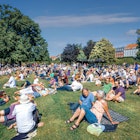
Copenhagen aims to be carbon-neutral by 2025 – here’s what that means for travellers
Mar 23, 2020 • 2 min read

Way back in 2011, Copenhagen City Council made an enlightened decision – to be the world’s first carbon-neutral capital city by 2025. Here’s what travellers need to know, and how visitors can contribute to this understated Danish revolution.

How Copenhagen is becoming carbon-neutral
Most of the carbon savings in Copenhagen come from changing the generation of electricity and heat to carbon-neutral fuels such as waste-to-energy, biomass, wind and solar. Wind turbines at Prøvestenen, Middelgrunden and Lynetten can be seen from most places in town, and the Copenhagen International School has the world’s largest solar panel facade. The Carlsberg City, Nordhavn and Ørsted redevelopment precincts have roof-mounted solar photovoltaics and government grants will replace old tiled roofs with integrated solar systems.

Green transport options
Denmark's capital city is working on smart urban design that integrates carbon-neutral public transport. Buses are being switched to those that use cleaner fuels such as electricity and biogas. Copenhagen's city centre is full of pedestrian-friendly streets and squares, perfect for a leisurely wander while discovering the city on foot.
Since the city is flat and most of the tourist attractions are in close proximity, visitors can try a quintessentially Copenhagen experience – getting about by bicycle. There are oodles of bike hire options, ranging from the Bycyklen and Donkey Republic networks, to bicycle hire stores scattered liberally throughout the city. Explore the circular Harbour Route (Havneringen) using one of the car-free bridges, such as the new Lille Langebro, or explore further afield using the large network of bicycle superhighways and 43km of greenways.
Copenhagen is well served by the buses and train networks, and bikes can be carried on all trains. The relatively new Metro network connects the airport and city, most tourist attractions are now within a short walk from a Metro station and the modern Danish design of the network is an attraction in its own right. The system is integrated so tickets are valid on buses, trains and harbour ferries.

Waste management in Copenhagen
Waste management practices will vary between accommodation providers, but all visitors can help improve the efficiency of the Copenhill waste-to-energy plant by segregating wastes such as glass, metals and batteries. Glass recycling stations are located around the city and bottles and cans with pant (deposit) stickers can be recycled in reverse vending machines inside supermarkets for a refund. Airbnb residents will be expected to segregate waste into the communal bins provided, and use the small organic waste bin so organics can be converted into biomethane.
Copenhagen provides a model of carbon-neutral cities of the future – and visitors can be a part of the change.
You might also like:
How sustainable are planes, trains and coaches on top European routes?
Best places to eat in Copenhagen in 2020
How to spend a perfect weekend in Copenhagen
Explore related stories





 Art and CultureThe 20 best free things to do in Copenhagen, from mermaids to museums
Art and CultureThe 20 best free things to do in Copenhagen, from mermaids to museumsAug 12, 2024 • 10 min read
 Wildlife & NatureThe best day trips from Copenhagen to explore more of Denmark (and beyond)
Wildlife & NatureThe best day trips from Copenhagen to explore more of Denmark (and beyond)Apr 30, 2024 • 7 min read



